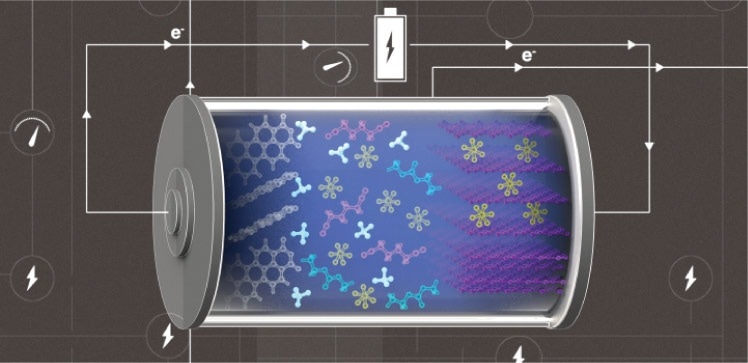According to KAUST researchers, rechargeable batteries that use ammonium cations as charge carriers could offer eco-friendly and long-lasting alternatives to metal-ion-based batteries.
 Illustration of the high-efficiency metal-free battery developed by KAUST researchers. Unlike conventional batteries, this battery combines an ammonium-cation-containing electrolyte with carbon-based electrodes. Image Credit: 2022 KAUST; Heno Hwang
Illustration of the high-efficiency metal-free battery developed by KAUST researchers. Unlike conventional batteries, this battery combines an ammonium-cation-containing electrolyte with carbon-based electrodes. Image Credit: 2022 KAUST; Heno Hwang
Lithium-ion batteries and other metal-ion batteries are the preferred types of energy storage. Due to their high energy density and versatility, they are the industry leaders in portable consumer electronics and electric vehicles.
However, the limited and depleting resources from which the metal ions used in the electrolytes are derived pose a threat to their long-term availability. For example, their flammability and toxicity could be hazardous to human health and the environment.
Due to the lightweight, simplicity of synthesis, and ease of recycling of these cations, there have been numerous attempts to create ammonium-ion-based batteries to address sustainability and environmental issues.
The batteries’ ability to operate at their maximum capacity is limited by the ammonium cations’ propensity for reduction into hydrogen and ammonia at a low operating potential. Additionally, they are tricky to incorporate into electrode materials because they dissolve easily in electrolytes.
Postdoc Zhiming Zhao, Husam Alshareef, and colleagues were able to create a high-efficiency metal-free battery by combining an ammonium-cation-containing electrolyte with electrodes made of carbon. According to Zhao, the organic semiconductor anode is cheap, sustainable, and made of graphite.
The scientists developed a “dual-ion” battery by using hexafluorophosphate ions as negative charge carriers for the ammonium cations and taking advantage of graphite’s capacity to reversibly accommodate these anions within its layers.
When the battery is charging, cations and anions are simultaneously inserted into the appropriate electrode, and when the battery is discharging, they are released into the electrolyte.
This sets this research apart from other studies, according to Zhao.
We designed an electrolyte that is both antioxidative and antireductive by screening a series of solvents resistant to high voltage and also taking into account its reduction stability.
Zhiming Zhao, Postdoctoral Researcher, King Abdullah University of Science and Technology
While its antireductive counterpart created a solvation sphere around the cations involved in the anode reaction, the antioxidative solvent primarily solvated anions participating in the cathode reaction.
Zhao added, “This configuration is crucial for battery stability.”
With a record operating voltage of 2.75 volts, the battery outperformed ammonium-ion-based analogs currently on the market.
“It is now possible to develop high-energy nonmetallic ion batteries that can compete with metal-ion batteries,” further stated Zhao.
The group is presently focusing on performance improvement to get closer to large-scale applications.
Zhao further added, “We are exploring anode materials with a higher capacity, which is crucial for improving the energy density.”
Alshareef’s team is creating inexpensive lithium-ion battery substitutes, especially for grid-scale storage.
To eventually completely decarbonize the grid, the battery costs must significantly come down.
Husam Alshareef, Professor, Material Science and Engineering, King Abdullah University of Science and Technology
These expenses can be reduced by using nonmetallic charge carriers in place of lithium, such as ammonium ions.
Journal Reference:
Zhao, Z., et al. (2022) A 2.75 V ammonium-based dual-ion battery. Angewandte Chemie International Edition. doi:10.1002/anie.202212941.